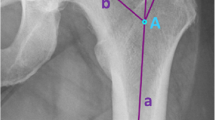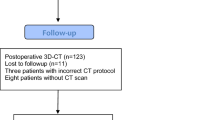Abstract
Background
Total hip arthroplasty (THA) is the gold standard procedure for patients with end-stage osteoarthritis after failed conservative therapy. Digital templating is commonly employed in preoperative preparation for THA and contributes positively to its outcome. However, the impact of coxa valga and antetorta (CVA) configurations on stem size prediction accuracy remains not reported. Previous studies demonstrated that the size of the lesser trochanter (LT) can be used to determine femoral anteversion on pelvis radiographs. This study investigates the accuracy of preoperative digital templating in predicting stem size in patients with CVA undergoing cementless THA.
Methods
Preoperative radiographs of 620 patients undergoing cementless THA were retrospectively investigated. Radiographs were standardized with patients standing and the leg internally rotated by 15°. A CVA group was established including patients with a CCD angle greater than 140° and a lesser trochanter (LT) size of at least 10 mm for men and 8 mm for women. For the control group, radiographs with a CCD angle ranging from 125–135° and LT size 3–10 mm for men and 3–8 mm for women were selected. Preoperative templating was performed using mediCAD. To reduce confounding factors, case-control matching was carried out for BMI and body height.
Results
After case-control matching, a total of thirty-one matches were analyzed. Stem size was underestimated in 74% (23/31) in the CVA and 13% (4/31) in the control group (p < 0.001). Moreover, patients with CVA were more likely to be underestimated by two sizes compared to controls (p < 0.004). In contrast, the exact stem size was predicted more frequently in the control group (p < 0.001).
Conclusion
Stem size in patients with a CVA configuration are at high risk of being underestimated when using digital templating. These findings can be valuable for guiding in intraoperative decisions and lowering the risk of complications associated with an undersized femoral component.


Similar content being viewed by others
Abbreviations
- ANOVA:
-
Analysis of Variance
- BMI:
-
Body Mass Index
- CCD:
-
Centrum Collum Diaphysis
- CT:
-
Computer Tomography
- CVA:
-
Coxa Valga and Antetorta
- LT:
-
Lesser Trochanter
- MRI:
-
Magnetic Resonance Imaging
- THA:
-
Total Hip Arthroplasty
References
Learmonth ID, Young C, Rorabeck C (2007) The operation of the century: total hip replacement. Lancet (London England) 370:1508–1519. https://doi.org/10.1016/S0140-6736(07)60457-7
Kong L, Chen L, Sun L, Tian X (2020) Direct anterior approach or posterior approach in total hip arthroplasty: a direct comparative study protocol. Med (Baltim) 99:e22717. https://doi.org/10.1097/MD.0000000000022717
Maradit Kremers H, Larson DR, Crowson CS et al (2015) Prevalence of total hip and knee replacement in the United States. J Bone Joint Surg Am 97:1386–1397. https://doi.org/10.2106/JBJS.N.01141
Girgis SF, Kohli S, Kouklidis G et al (2023) The Accuracy of Digital Preoperative Templating in primary total hip replacements. Cureus 15:e43046. https://doi.org/10.7759/cureus.43046
Della Valle AG, Padgett DE, Salvati EA (2005) Preoperative planning for primary total hip arthroplasty. J Am Acad Orthop Surg 13:455–462. https://doi.org/10.5435/00124635-200511000-00005
Colombi A, Schena D, Castelli CC (2019) Total hip arthroplasty planning. EFORT open Rev 4:626–632. https://doi.org/10.1302/2058-5241.4.180075
Aubert T, Galanzino G, Gerard P et al (2023) Accuracy of preoperative 3D vs 2D Digital Templating for Cementless Total Hip Arthroplasty using a direct Anterior Approach. Arthroplast Today 24:101260. https://doi.org/10.1016/j.artd.2023.101260
Holzer LA, Scholler G, Wagner S et al (2019) The accuracy of digital templating in uncemented total hip arthroplasty. Arch Orthop Trauma Surg 139:263–268. https://doi.org/10.1007/s00402-018-3080-0
Efe T, El Zayat BF, Heyse TJ et al (2011) Precision of preoperative digital templating in total hip arthroplasty. Acta Orthop Belg 77:616–621
Sinclair VF, Wilson J, Jain NPM, Knowles D (2014) Assessment of accuracy of marker ball placement in pre-operative templating for total hip arthroplasty. J Arthroplasty 29:1658–1660. https://doi.org/10.1016/j.arth.2014.03.013
Schmaranzer F, Meier MK, Lerch TD et al (2022) Coxa valga and antetorta increases differences among different femoral version measurements: potential implications for derotational femoral osteotomy planning. Bone Jt open 3:759–766. https://doi.org/10.1302/2633-1462.310.BJO-2022-0102.R1
Marchand LS, Todd DC, Kellam P et al (2018) Is the lesser Trochanter Profile a Reliable means of restoring anatomic Rotation after Femur fracture fixation? Clin Orthop Relat Res 476:1253–1261. https://doi.org/10.1007/s11999.0000000000000226
Worlicek MC, Wörner ML, Craiovan BS et al (2017) Lesser Trochanter size on plain anteroposterior radiographs correlates with native femoral anteversion. J Arthroplasty 32:2892–2897. https://doi.org/10.1016/j.arth.2017.03.054
Desai AS, Dramis A, Board TN (2013) Leg length discrepancy after total hip arthroplasty: a review of literature. Curr Rev Musculoskelet Med 6:336–341. https://doi.org/10.1007/s12178-013-9180-0
Haddad FS, Masri BA, Garbuz DS, Duncan CP (1999) The prevention of periprosthetic fractures in total hip and knee arthroplasty. Orthop Clin North Am 30:191–207. https://doi.org/10.1016/s0030-5898(05)70074-2
Kelmer G, Stone AH, Turcotte J, King PJ (2021) Reasons for revision: primary total hip arthroplasty mechanisms of failure. J Am Acad Orthop Surg 29:78–87. https://doi.org/10.5435/JAAOS-D-19-00860
Hananouchi T, Sugano N, Nakamura N et al (2007) Preoperative templating of femoral components on plain X-rays. Rotational evaluation with synthetic X-rays on ORTHODOC. Arch Orthop Trauma Surg 127:381–385. https://doi.org/10.1007/s00402-007-0349-0
Streit MR, Innmann MM, Merle C et al (2013) Long-term (20- to 25-year) results of an uncemented tapered titanium femoral component and factors affecting survivorship. Clin Orthop Relat Res 471:3262–3269. https://doi.org/10.1007/s11999-013-3033-4
Fottner A, Woiczinski M, Kistler M et al (2017) Influence of undersized cementless hip stems on primary stability and strain distribution. Arch Orthop Trauma Surg 137:1435–1441. https://doi.org/10.1007/s00402-017-2784-x
Kim YH, Kim VE (1993) Early migration of uncemented porous coated anatomic femoral component related to aseptic loosening. Clin Orthop Relat Res 146–155
Dammerer D, Keiler A, Herrnegger S et al (2022) Accuracy of digital templating of uncemented total hip arthroplasty at a certified arthroplasty center: a retrospective comparative study. Arch Orthop Trauma Surg 142:2471–2480. https://doi.org/10.1007/s00402-021-03836-w
Brenneis M, Braun S, van Drongelen S et al (2021) Accuracy of Preoperative Templating in Total Hip Arthroplasty with Special Focus on Stem morphology: a randomized comparison between Common Digital and three-Dimensional Planning using biplanar radiographs. J Arthroplasty 36:1149–1155. https://doi.org/10.1016/j.arth.2020.10.016
Schiffner E, Latz D, Jungbluth P et al (2019) Is computerised 3D templating more accurate than 2D templating to predict size of components in primary total hip arthroplasty? Hip Int J Clin Exp Res hip Pathol Ther 29:270–275. https://doi.org/10.1177/1120700018776311
Lerch TD, Todorski IAS, Steppacher SD et al (2018) Prevalence of femoral and Acetabular Version Abnormalities in patients with symptomatic hip disease: a controlled study of 538 hips. Am J Sports Med 46:122–134. https://doi.org/10.1177/0363546517726983
Wells J, Nepple JJ, Crook K et al (2017) Femoral morphology in the dysplastic hip: three-dimensional characterizations with CT. Clin Orthop Relat Res 475:1045–1054. https://doi.org/10.1007/s11999-016-5119-2
Hesham K, Carry PM, Freese K et al (2017) Measurement of femoral version by MRI is as Reliable and reproducible as CT in Children and adolescents with Hip disorders. J Pediatr Orthop 37:557–562. https://doi.org/10.1097/BPO.0000000000000712
Funding
This research received no specific grant from any funding agency in the public, commercial, or not-for-profit sectors.
Author information
Authors and Affiliations
Contributions
Conradin Schweizer: Conceptualization, Investigation, data curation, formal analysis, writing—original draft, writing—review & editing Oliver Niggemeyer: writing—review & editing, supervision Jan-Hauke Jens: writing—review & editing Marius Junker: Conceptualization, methodology, investigation, data curation, writing—original draft, writing—review& editing, visualization, project administration. All authors read and approved the final manuscript.
Corresponding author
Ethics declarations
Ethical approval
This study was approved by the local ethics committee (2024-300433-WF).
Conflict of interest
On behalf of all authors, the corresponding author states that there is no conflict of interest.
Additional information
Publisher’s Note
Springer Nature remains neutral with regard to jurisdictional claims in published maps and institutional affiliations.
Rights and permissions
Springer Nature or its licensor (e.g. a society or other partner) holds exclusive rights to this article under a publishing agreement with the author(s) or other rightsholder(s); author self-archiving of the accepted manuscript version of this article is solely governed by the terms of such publishing agreement and applicable law.
About this article
Cite this article
Schweizer, C., Niggemeyer, O., Jens, JH. et al. Coxa valga and antetorta configuration leads to underestimation of the femoral component size: a matched case-control study of patients undergoing cementless total hip arthroplasty. Arch Orthop Trauma Surg (2024). https://doi.org/10.1007/s00402-024-05373-8
Received:
Accepted:
Published:
DOI: https://doi.org/10.1007/s00402-024-05373-8




